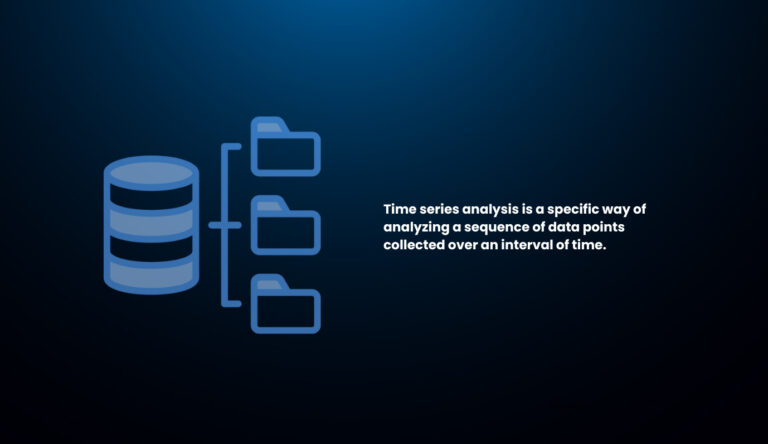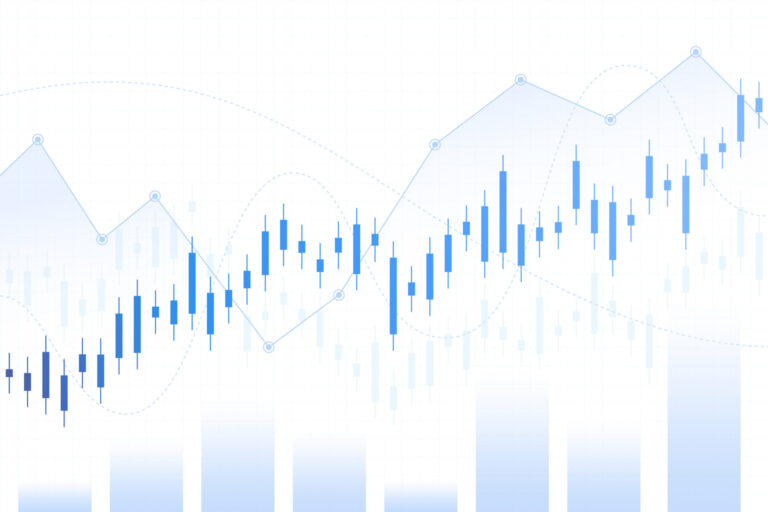Table of Contents
In a world where the only constant is change, our ability to predict the future is an invaluable asset. Today, we can precisely forecast the ebb and flow of stock markets, anticipate the strain on healthcare systems during a pandemic, or accurately project the demand for the season’s hottest fashion item.
This capability extends far beyond mere guesswork; it’s rooted in the scientific method of time series forecasting. But what exactly is time series forecasting, and why has it become a linchpin in various industries? Let’s see it in more detail!
What is time series forecasting?
Time series forecasting covers a variety of statistical and data science techniques focused on predicting variables that evolve over time. This involves identifying patterns within the data and using obtained insights to make short- or long-term predictions about these changes based on the established patterns.
For example, in the retail sector, the decision-making process regarding inventory stocking and distribution relies heavily on anticipated regional demand trends. In cloud computing, future service and infrastructure utilisation predictions are key to strategic capacity planning.
Furthermore, workforce allocation depends on projected workloads in settings like warehouses, call centres, and manufacturing plants. The evolution in forecasting methods has been notable in recent years, transitioning from traditional, model-based approaches assisted by computers to modern, automated strategies rooted in data analysis.
Time series forecasting is a technique with use cases spanning a variety of real-world scenarios, including but not limited to:
- Forecasting COVID-19 spread
- Predicting Bitcoin prices
- Estimating airport flight schedules
- Anticipating daily wind power generation
- Predicting avalanches at resorts
- Projecting web traffic for a website, etc.
What is time series analysis?
Moving from forecasting to analysis, let’s clarify the distinction. Time series analysis involves dissecting data to understand the ‘what’ and ‘why’ of historical changes.
It’s less about predicting the future and more about understanding past patterns. In contrast, forecasting is more future-oriented, concentrating on predicting what is likely to occur next.

What is time-series data?
In various domains like business, economics, medicine, and diverse scientific disciplines, time series data commonly display patterns, including trends, seasonal variations, irregular cycles, and sporadic shifts in variability.
The goals of analysing these series typically involve extrapolating the dynamic patterns in the data to forecast future events, assessing the impact of known external interventions, and uncovering any unexpected interventions.
Patterns of time series forecasting
There are several characteristics of time-series data that need to be taken into account when modelling time-series data:
- A trend component describes the way the variable changes over long periods of time. Often, a trend is described as ‘changing direction’ when it shifts from an increasing to a decreasing pattern or vice versa.
- A seasonal pattern in time series is evident when the data is influenced by periodic factors, such as specific times of the year or days of the week. A fixed and predictable frequency characterises this seasonality.
For example, the monthly sales of anti-diabetic drugs demonstrate such a seasonal trend. This can be partially attributed to variations in drug costs towards the year’s end, reflecting how external factors can induce seasonality in data. - Cycles in time series data are long-term patterns characterised by a waveform and recurring nature, related to seasonal patterns but without a fixed duration.
Unlike seasonality, cycles don’t adhere to a strict time frame and can vary in length. A classic example of this is seen in business cycles, which typically include phases of growth, recession, and recovery. - Irregular components in time series data arise from unforeseen events like natural disasters. These components are typically unpredictable and do not follow a regular pattern or cycle, distinguishing them from other more systematic elements in the data.
Introduction to time series and forecasting: key components
Time series analysis comprises six primary components – these steps are the cornerstone of time series data analysis, resulting in accurate further forecasting.
- Data Preparation is the foundation of any time series analysis. This stage entails gathering relevant historical time series data and scrutinising it for accuracy. At this point, it is important to identify and address any missing values or outliers in the dataset.
Moreover, the data is evaluated for stationarity, a fundamental assumption in time series modelling. If the data is not stationary, appropriate transformations stabilise its statistical properties over time, thereby preparing it for further analysis.
- Exploratory Data Analysis facilitates an initial understanding of the data’s patterns and characteristics. This phase employs statistical techniques to delve into trends, seasonality, correlations, and cyclical behaviours inherent in the data.
Visual tools, such as time series plots, autocorrelation function (ACF), and partial autocorrelation function (PACF) graphs, are extensively utilised for a preliminary examination of these underlying elements.
EDA also involves identifying and documenting any unusual observations or anomalies, setting the stage for more detailed analysis.
- Model Identification involves choosing the most appropriate time series forecasting model that aligns with the data’s characteristics.
There are the best time series forecasting models such as AR (Autoregressive), MA (Moving Average), ARMA (Autoregressive Moving Average), etc that are guided by the patterns identified during the exploratory analysis phase.
Model identification also involves determining the necessary number of terms and the appropriate lag structure for the model. This stage heavily relies on statistical tests to ascertain the most suitable model that fits the data effectively.

4. Model Forecasting involves applying the identified model to historical data to forecast one or more future periods. The accuracy of these forecasts is critically evaluated using key metrics on test datasets.
This evaluation phase helps to assess the model’s performance and reliability in predicting future data points. Additionally, if necessary, supplementary variables can be incorporated into the model to improve the accuracy of the forecast.
5. Model Maintenance, the final step in the time series analysis, focuses on the ongoing assessment of the model’s performance. As fresh actual data becomes available, it is essential to periodically re-evaluate the model to ensure it remains accurate and relevant.
This may involve updating the model to accommodate new trends, patterns, or changes in its forecasting environment. Regular maintenance ensures that the model provides reliable and effective forecasts, adapting as necessary to evolving conditions and behaviours over time.
6. Application Domains – the concepts and models developed through time series analysis can be broadly applied across numerous fields that exhibit time dependency.
This versatility allows for various applications, such as demand forecasting in business, sales prediction, analysing stock market trends, and numerous other areas. The adaptability of time series analysis to different domains underscores its importance in making informed, predictive decisions based on temporal data patterns.
What are the time series forecasting methods?
Time series analysis employs numerous statistical models and techniques to identify patterns and make predictions using data over time.
- Moving average is suitable for smoothing out long-term trends and identifying the direction values move.
- Exponential smoothing works best with univariate data with a systematic trend or seasonal component. It prioritises recent observations, allowing for more dynamic adjustments.
- Autoregression, good for short-term forecasting, uses past observations as inputs for a regression equation to forecast future values.
- Decomposition splits a time series into its core components—trend, seasonality, and residuals—to improve understanding and prediction accuracy.
- Time Series Clustering categorises data points based on similarity, helping to identify archetypes or trends in sequential data.
- Wavelet Analysis helps to analyse non-stationary time series data and identify patterns across various scales or resolutions.
- Intervention Analysis evaluates the influence of external events on a time series, such as the result of a policy change or a marketing campaign.
Numerous time series forecasting models have arisen from statistics, econometrics, signal processing, and machine learning.
Linear models such as ARIMA, distinguished by their simplicity and interpretability, offer valuable tools for analysis. At the same time, using deep learning for time series forecasting can cope with complex time series that cannot usually be handled by other machine learning techniques.
This rich diversity of modelling techniques equips practitioners with a versatile toolkit to effectively address a broad spectrum of temporal data challenges.
Examples of time series forecasting
Now, let’s explore how time series forecasting is applied in different sectors.
Finance
In light of the prevailing enthusiasm surrounding FinTech and AI, there has been a notable surge in the analysis and prediction of financial time-series data about global financial markets. Thus, businesses employ time series forecasting and analysis for:
- Stock market assessment: By analysing historical data, models can forecast future stock performance, assisting investors in making informed decisions.
- Risk management: Time series forecasting helps assess and manage risks by predicting market volatility, credit risk, and liquidity risk, enabling financial institutions to develop more efficient strategies to mitigate potential losses.
- Algorithmic trading: Automated trading systems use time series analysis to predict future market fluctuations and execute trades, accordingly, optimising for maximum profits.
- Economic forecasting: The prediction of economic indicators such as inflation rates, GDP growth, and unemployment rates assists policymakers and businesses in strategic planning.
- Portfolio management: Asset managers use time series forecasting to optimise asset allocation, balance risks, and maximise returns for investment portfolios.
- Loan and credit scoring: Financial institutions predict credit risk by analysing repayment histories and financial behaviours over time, improving the accuracy of loan approvals and interest rate determination.
- Demand forecasting in banking services: Banks and financial institutions forecast the demand for various financial products and services, which helps in resource allocation and service optimisation.
- Fraud detection: By analysing transaction time series, fintech companies can detect unusual patterns indicative of fraudulent activity, enhancing security measures.
- Interest rate prediction: Predicting interest rate changes is essential for various financial activities, including bond investing and mortgage lending.
- Budgeting and financial planning: Businesses use time series forecasting for revenue and expense predictions, facilitating budgeting and financial planning.
Retail
Time series analysis is widely employed in many fields, including retail, to forecast future events based on historical data, which results in:
- Enhanced inventory management: The precision of sales forecasts empowers the businesses to uphold optimal inventory levels, thereby mitigating the occurrences of stockouts and overstock situations.
- Improved resource allocation: By leveraging dependable sales forecasts, the company can allocate resources, including personnel and marketing efforts, more efficiently.
- Informed decision-making: The application of time series analysis yields invaluable insights into sales patterns and trends, furnishing the company with the capability to make informed decisions and proactively adapt to evolving market dynamics.
- Profitability: Through the optimisation of inventory management and resource allocation, the organisation can curtail expenses and drive increased sales, ultimately resulting in increased profitability.
- Revenue prediction: Retail businesses forecast revenue trends to plan budgets and make investment decisions.
- Store performance analysis: Time series data helps compare performance across different time periods and store locations, identifying trends and areas for improvement.
- Workforce management: Retailers can forecast busy periods and staff, accordingly, ensuring efficient customer service without overspending on labour.
- Promotional planning: By analysing past sales data during promotions, retailers can forecast the impact of future promotional activities on sales and stock levels.
- Trend analysis: Identifying long-term trends in consumer behaviour, product popularity, and market dynamics helps in strategic planning.
Healthcare
Within medical applications, time series forecasting models have demonstrated notable success, covering:
- Disease outbreak prediction: Forecasting the outbreak and spread of diseases helps prepare healthcare systems for increased demand and implementing preventive measures.
- Patient admission rates: Predicting hospital admission rates enables better staffing and resource allocation, ensuring adequate patient care without overburdening healthcare facilities.
- Drug demand forecasting: Accurately predicting the demand for various medications helps manage pharmacy inventory, reduce wastage, and ensure critical drug availability.
- Resource allocation: Forecasting the need for medical equipment, beds, and other resources helps hospitals manage their resources more efficiently and effectively.
- Public health planning: Predicting trends in public health issues (like obesity or smoking rates) aids in planning and implementing public health initiatives.
- Epidemiological studies: Time series analysis is crucial in tracking the progression of diseases over time, aiding in epidemiological research and public health strategies.
- Staffing and scheduling: Forecasting patient flow enables hospitals and clinics to optimise staffing schedules, ensuring adequate healthcare provision at all times.
- Medical research and clinical trials: Time series data can be used to track the progress and outcomes of clinical trials and medical research over time.
- Preventive healthcare: Analysing trends in patient data helps identify risk factors for diseases, enabling early intervention and preventive healthcare measures.
- Healthcare expenditure forecasting: Predicting future healthcare costs helps governments and insurance companies in budgeting and policymaking.
- Telehealth demand prediction: As telehealth becomes more prevalent, forecasting its demand helps in resource allocation and technology investment.
Conclusion
To wrap up, time series forecasting is not just about crunching numbers or plotting graphs; it’s about understanding the past to make informed predictions about the future.
Our journey through the landscape of time series forecasting reveals it has proven to be a key player in strategic planning across diverse industries. From predicting stock market trends to managing retail inventories and forecasting health crises, its applications are as varied as they are impactful.
When used effectively, it’s a tool that can offer significant insights and guide better decision-making.
As a time series analysis and forecasting service provider, Altamira is dedicated to helping you make data-driven decisions.
Our advanced algorithms and niche expertise can be a valuable asset for you in anticipating trends, optimising resource allocation, and making strategic decisions for a future-ready business. Contact us to learn more about predictive analytics opportunities and our cutting-edge time series forecasting solutions.



